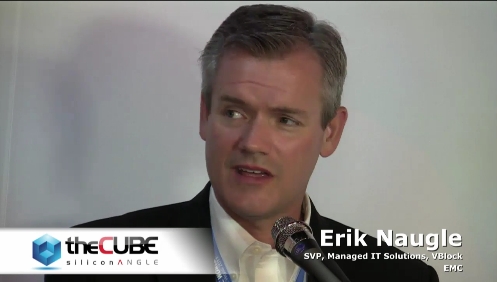 NEWS
NEWS
 NEWS
NEWS
 NEWS
NEWS
“One of the best ways of reducing the cost of electricity is to get customers in their houses ![]() to moderate their electrical usage during peak demand hours by doing things like turning off their pool pump or air conditioning or delay recharging electric cars until off-peak times,” says Erik Naugle, SVP for Managed IT Solutions at SAIC. The problem, particularly for small utilities, he told Wikibon.org Co-Founder David Vellante and SiliconAngle Founder John Furrier in an interview on SiliconAngle.TV from EMCworld 2011, is that to do that they really need to incentivise customers with differential pricing – a higher rate for on-peak power than for off-peak. But the traditional electro-mechanical meter system with manual monthly readings does not support that.
to moderate their electrical usage during peak demand hours by doing things like turning off their pool pump or air conditioning or delay recharging electric cars until off-peak times,” says Erik Naugle, SVP for Managed IT Solutions at SAIC. The problem, particularly for small utilities, he told Wikibon.org Co-Founder David Vellante and SiliconAngle Founder John Furrier in an interview on SiliconAngle.TV from EMCworld 2011, is that to do that they really need to incentivise customers with differential pricing – a higher rate for on-peak power than for off-peak. But the traditional electro-mechanical meter system with manual monthly readings does not support that.
What this requires is what SAIC calls a “smart grid” with digital meters on houses that gather detailed information on each customer’s daily electrical use and transmits it digitally over the electric lines to a computer system that runs several Oracle and SQL applications designed specifically for utilities, thereby allowing them to track minute-to-minute demand levels at each house. It also can allow the utility to offer its customers automated tools to manage and in some cases automate management of their energy use.
But this requires a large IT investment and advanced skill sets that these small cooperatives and municipal utilities cannot afford. So SAIC, a traditional, U.S.-based outsourcer, is offering this as software-as-a-service (SaaS). Not only does this provide these smaller utilities with a solution to their own problem of managing expensive peak electrical use, it allows them to modernize their IT operations and in the process handle the large amounts of data – orders of magnitude larger than they are used to, in a secure manner.
The SAIC service, Naugle says, is completely virtualized on VMware – yes SAIC does virtualize Oracle applications although, Naugle says, Oracle doesn’t like that – and running on Vblocks. Like most SaaS services, it shares database and application use among multiple customers while using the internal tools in the database to keep each customer’s data completely separate and secure from any other user. This allows it to run its IT shop on a scale equivalent to that of a large enterprise and pass the cost savings that volume produces on to users.
Security is a concern with the utilities, he says, and for instance SAIC uses VPN tunnels to protect data in transit from the dangers of the public Internet. Cost is a lager issue, but the efficiencies of the SaaS model allow SAIC to price for the market. And the big benefit it provides the utilities is the ability to limit their purchases of more expensive peak power. Because no practical way exists to store power in large quantities, it has to be generated to meet demand. Electricity generating companies have two kinds of facilities – the base generating stations that provide basically a basic level of power 24X7X365, and more expensive peak generating facilities that turn on and off, and increase or decrease generation to meet momentary changes in demand. That peak power is more expensive to generate.
The small utilities usually do not have their own generating systems. They buy their power from large utilities, and they pay more for that peak power. So the smart grid gives them a tool to control that expense, which means they can decrease their expenses and their overall rates to users. It also allows them to automate billing and paying and offer customers options such as automatic paying. And they can reduce their bad debt by requiring those customers to prepay. So the service does offer several advantages to the utilities and promises lower rates and better control over utility bills to customers.
THANK YOU